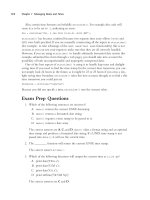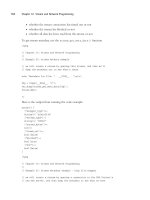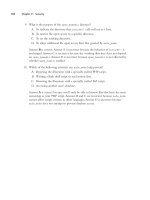Tài liệu Zend PHP Certification Study Guide- P3 docx
Bạn đang xem bản rút gọn của tài liệu. Xem và tải ngay bản đầy đủ của tài liệu tại đây (114.73 KB, 20 trang )
24
Chapter 1 The Basics of PHP
default:
echo ‘I don\’t know what to do’;
break;
}
?>
When the interpreter encounters the switch keyword, it evaluates the expression that
follows it and then compares the resulting value with each of the individual case condi-
tions. If a match is found, the code is executed until the keyword break or the end of
the switch code block is found, whichever comes first. If no match is found and the
default code block is present, its contents are executed.
Note that the presence of the break statement is essential—if it is not present, the
interpreter will continue to execute code in to the next case or default code block,
which often (but not always) isn’t what you want to happen.You can actually turn this
behavior to your advantage to simulate a logical or operation; for example, this code
<?php
if ($a == 1 || $a == 2)
{
echo ‘test one’;
}
else
{
echo ‘test two’;
}
?>
Could be rewritten as follows:
<?php
switch ($a)
{
case 1:
case 2:
echo ‘test one’;
break;
default:
echo ‘test two’;
break;
}
?>
02 7090 ch01 7/16/04 8:44 AM Page 24
Please purchase PDF Split-Merge on www.verypdf.com to remove this watermark.
25
Iteration and Loops
Once inside the switch statement, a value of 1 or 2 will cause the same actions to take
place.
Iteration and Loops
Scripts are often used to perform repetitive tasks.This means that it is sometimes neces-
sary to cause a script to execute the same instructions for a number of times that
might—or might not—be known ahead of time. PHP provides a number of control
structures that can be used for this purpose.
The while Structure
A while statement executes a code block until a condition is set:
<?php
$a = 10;
while ($a < 100)
{
$a++;
}
?>
Clearly, you can use a condition that can never be satisfied—in which case, you’ll end up
with an infinite loop. Infinite loops are usually not a good thing, but, because PHP pro-
vides the proper mechanism for interrupting the loop at any point, they can also be use-
ful. Consider the following:
<?php
$a = 10;
$b = 50;
while (true)
{
$a++;
if ($a > 100)
{
$b++;
if ($b > 50)
{
break;
}
}
}
?>
02 7090 ch01 7/16/04 8:44 AM Page 25
Please purchase PDF Split-Merge on www.verypdf.com to remove this watermark.
26
Chapter 1 The Basics of PHP
In this script, the (true) condition is always satisfied and, therefore, the interpreter will
be more than happy to go on repeating the code block forever. However, inside the code
block itself, we perform two if-then checks, and the second one is dependent on the first
so that the $b > 50 will only be evaluated after $a > 100, and, if both are true, the
break statement will cause the execution point to exit from the loop into the preceding
scope. Naturally, we could have written this loop just by using the condition ($a <=
100 && $b <= 50) in the while loop, but it would have been less efficient because we’d
have to perform the check twice. (Remember, $b doesn’t increment unless $a is greater
than 100.) If the second condition were a complex expression, our script’s performance
might have suffered.
The do-while Structure
The big problem with the while() structure is that, if the condition never evaluates to
True, the statements inside the code block are never executed.
In some cases, it might be preferable that the code be executed at least once, and then
the condition evaluated to determine whether it will be necessary to execute it again.
This can be achieved in one of two ways: either by copying the code outside of the
while loop into a separate code block, which is inefficient and makes your scripts more
difficult to maintain, or by using a do-while loop:
<?php
$a = 10;
do
{
$a++;
}
while ($a < 10);
?>
In this simple script, $a will be incremented by one once—even if the condition in the
do-while statement will never be true.
The for Loop
When you know exactly how many times a particular set of instructions must be repeat-
ed, using while and do-while loops is a bit inconvenient. For this purpose, for loops are
also part of the arsenal at the disposal of the PHP programmer:
<?php
for ($i = 10; $i < 100; $i++)
{
02 7090 ch01 7/16/04 8:44 AM Page 26
Please purchase PDF Split-Merge on www.verypdf.com to remove this watermark.
27
Iteration and Loops
echo $i;
}
?>
As you can see, the declaration of a for loop is broken in to three parts:The first is used
to perform any initialization operations needed and is executed only once before the loop
begins.The second represents the condition that must be satisfied for the loop to contin-
ue. Finally, the third contains a set of instructions that are executed once at the end of
every iteration of the loop before the condition is tested.
A for loop could, in principle, be rewritten as a while loop. For example, the previ-
ous simple script can be rewritten as follows:
<?php
$i = 10;
while ($i < 100)
{
echo $i;
$i++;
}
?>
As you can see, however, the for loop is much more elegant and compact.
Note that you can actually include more than one operation in the initialization and
end-of-loop expressions of the for loop declaration by separating them with a comma:
<?php
for ($i = 1, $c = 2; $i < 10; $i++, $c += 2)
{
echo $i;
echo $c;
}
?>
Naturally, you can also create a for loop that is infinite—in a number of ways, in fact.
You could omit the second expression from the declaration, which would cause the
interpreter to always evaluate the condition to true.You could omit the third expression
and never perform any actions in the code block associated with the loop that will cause
the condition in the second expression to be evaluated as true.You can even omit all
three expressions using the form for(;;) and end up with the equivalent of
while(true).
02 7090 ch01 7/16/04 8:44 AM Page 27
Please purchase PDF Split-Merge on www.verypdf.com to remove this watermark.
28
Chapter 1 The Basics of PHP
Continuing a Loop
You have already seen how the break statement can be used to exit from a loop.What
if, however, you simply want to skip until the end of the code block associated with the
loop and move on to the next iteration?
In that case, you can use the continue statement:
<?php
for ($i = 1, $c = 2; $i < 10; $i++, $c += 2)
{
if ($c < 10)
continue;
echo ‘I\’ve reached 10!’;
}
?>
If you nest more than one loop, you can actually even specify the number of loops that
you want to skip and move on from:
<?php
for ($i = 1, $c = 2; $i < 10; $i++, $c += 2)
{
$b = 0;
while ($b < 199) {
if ($c < 10)
continue 2;
echo ‘I\’ve reached 10!’;
}
}
?>
In this case, when the execution reaches the inner while loop, if $c is less than 10, the
continue 2 statement will cause the interpreter to skip back two loops and start over
with the next iteration of the for loop.
Functions and Constructs
The code that we have looked at up to this point works using a very simple top-down
execution style:The interpreter simply starts at the beginning and works its way to the
end in a linear fashion. In the real world, this simple approach is rarely practical; for
example, you might want to perform a certain operation more than once in different
portions of your code.To do so, PHP supports a facility known as a function.
02 7090 ch01 7/16/04 8:44 AM Page 28
Please purchase PDF Split-Merge on www.verypdf.com to remove this watermark.
29
Functions and Constructs
Functions must be declared using the following syntax:
function function_name ([param1[, paramn]])
As you can see, each function is assigned a name and can receive one or more parame-
ters.The parameters exist as variables throughout the execution of the entire function.
Let’s look at an example:
<?php
function calc_weeks ($years)
{
return $years * 52;
}
$my_years = 28;
echo calc_weeks ($my_years);
?>
The $years variable is created whenever the calc_weeks function is called and initial-
ized with the value passed to it.The return statement is used to return a value from the
function, which then becomes available to the calling script.You can also use return to
exit from the function at any given time.
Normally, parameters are passed by value—this means that, in the previous example, a
copy of the $my_years variable is placed in the $years variable when the function
begins, and any changes to the latter are not reflected in the former. It is, however, possi-
ble to force passing a parameter by reference so that any changes performed within the
function to it will be reflected on the outside as well:
<?php
function calc_weeks (&$years)
{
$my_years += 10;
return $my_years * 52;
}
$my_years = 28;
echo calc_weeks ($my_years);
?>
You can also assign a default value to any of the parameters of a function when declaring
it.This way, if the caller does not provide a value for the parameter, the default one will
be used instead:
02 7090 ch01 7/16/04 8:44 AM Page 29
Please purchase PDF Split-Merge on www.verypdf.com to remove this watermark.
30
Chapter 1 The Basics of PHP
<?php
function calc_weeks ($my_years = 10)
{
return $my_years * 52;
}
echo calc_weeks ();
?>
In this case, because no value has been passed for $my_years, the default of 10 will be
used by the interpreter. Note that you can’t assign a default value to a parameter passed
by reference.
Functions and Variable Scope
It’s important to note that there is no relationship between the name of a variable
declared inside a function and any corresponding variables declared outside of it. In PHP,
variable scope works differently from most other languages so that what resides in the
global scope is not automatically available in a function’s scope. Let’s look at an example:
<?php
function calc_weeks ()
{
$years += 10;
return $years * 52;
}
$years = 28;
echo calc_weeks ();
?>
In this particular case, the script assumes that the $years variable, which is part of the
global scope, will be automatically included in the scope of calc_weeks(). However, this
does not take place, so $years has a value of Null inside the function, resulting in a
return value of 0.
If you want to import global variables inside a function’s scope, you can do so by
using the global statement:
<?php
function calc_weeks ()
{
global $years;
02 7090 ch01 7/16/04 8:44 AM Page 30
Please purchase PDF Split-Merge on www.verypdf.com to remove this watermark.
31
Functions and Constructs
$years += 10;
return $years * 52;
}
$years = 28;
echo calc_weeks ();
?>
The $years variable is now available to the function, where it can be used and modi-
fied. Note that by importing the variable inside the function’s scope, any changes made
to it will be reflected in the global scope as well—in other words, you’ll be accessing the
variable itself, and not an ad hoc copy as you would with a parameter passed by value.
Functions with Variable Parameters
It’s sometimes impossible to know how many parameters are needed for a function. In
this case, you can create a function that accepts a variable number of arguments using a
number of functions that PHP makes available for you:
n
func_num_args() returns the number of parameters passed to a function.
n
func_get_arg($arg_num) returns a particular parameter, given its position in the
parameter list.
n
func_get_args() returns an array containing all the parameters in the parameter
list.
As an example, let’s write a function that calculates the arithmetic average of all the
parameters passed to it:
<?php
function calc_avg()
{
$args = func_num_args();
if ($args == 0)
return 0;
$sum = 0;
for ($i = 0; $i < $args; $i++)
$sum += func_get_arg($i);
return $sum / $args;
}
echo calc_avg (19, 23, 44, 1231, 2132, 11);
?>
02 7090 ch01 7/16/04 8:44 AM Page 31
Please purchase PDF Split-Merge on www.verypdf.com to remove this watermark.
32
Chapter 1 The Basics of PHP
As you can see, we start by determining the number of arguments and exiting immedi-
ately if there are none.We need to do so because otherwise the last instruction would
cause a division-by-zero error. Next, we create a for loop that simply cycles through
each parameter in sequence, adding its value to the sum. Finally, we calculate and return
the average value by dividing the sum by the number of parameters. Note how we
stored the value of the parameter count in the $args variable—we did so in order to
make the script a bit more efficient because otherwise we would have had to perform a
call to func_get_args() for every cycle of the for loop. That would have been rather
wasteful because a function call is quite expensive in terms of performance and the
number of parameters passed to the function does not change during its execution.
Variable Variables and Variable Functions
PHP supports two very useful features known as “variable variables” and “variable func-
tions.”
The former allows you use the value of a variable as the name of a variable. Sound
confusing? Look at this example:
<?
$a = 100;
$b = ‘a’;
echo $$b;
?>
When this script is executed and the interpreter encounters the $$b expression, it first
determines the value of $b, which is the string a. It then reevaluates the expression with
a substituted for $b as $a, thus returning the value of the $a variable.
Similarly, you can use a variable’s value as the name of a function:
<?
function odd_number ($x)
{
echo “$x is odd”;
}
function even_number ($x)
{
echo “$x is even”;
}
$n = 15;
$a = ($n % 2 ? ‘odd_number’ : ‘even_number’);
02 7090 ch01 7/16/04 8:44 AM Page 32
Please purchase PDF Split-Merge on www.verypdf.com to remove this watermark.
33
Exam Prep Questions
$a($n);
?>
At the end of the script, $a will contain either odd_number or even_number.The expres-
sion $a($n) will then be evaluated as a call to either odd_number() or even_number().
Variable variables and variable functions can be extremely valuable and convenient.
However, they tend to make your code obscure because the only way to really tell what
happens during the script’s execution is to execute it—you can’t determine whether
what you have written is correct by simply looking at it.As a result, you should only
really use variable variables and functions when their usefulness outweighs the potential
problems that they can introduce.
Exam Prep Questions
1. What will the following script output?
<?php
$x = 3 - 5 % 3;
echo $x;
?>
A. 2
B. 1
C. Null
D. Tr ue
E. 3
Answer B is correct. Because of operator precedence, the modulus operation is
performed first, yielding a result of 2 (the remainder of the division of 5 by 2).
Then, the result of this operation is subtracted from the integer 3.
2. Which data type will the $a variable have at the end of the following script?
<?php
$a = “1”;
echo $x;
?>
02 7090 ch01 7/16/04 8:44 AM Page 33
Please purchase PDF Split-Merge on www.verypdf.com to remove this watermark.
34
Chapter 1 The Basics of PHP
A. (int) 1
B. (string) “1”
C. (bool) True
D. (float) 1.0
E. (float) 1
Answer B is correct.When a numeric string is assigned to a variable, it remains
a string, and it is not converted until needed because of an operation that
requires so.
3. What will the following script output?
<?php
$a = 1;
$a = $a— + 1;
echo $a;
?>
A. 2
B. 1
C. 3
D. 0
E. Null
Answer A is correct.The expression $a— will be evaluated after the expression $a
= $a + 1 but before the assignment.Therefore, by the time $a + 1 is assigned to
$a, the increment will simply be lost.
02 7090 ch01 7/16/04 8:44 AM Page 34
Please purchase PDF Split-Merge on www.verypdf.com to remove this watermark.
2
Object-Oriented PHP
DESPITE BEING A RELATIVELY RECENT—and often maligned—addition to the comput-
er programming world, object-oriented programming (OOP) has rapidly taken hold as
the programming methodology of choice for the enterprise.
The basic concept behind OOP is encapsulation—the grouping of data and code ele-
ments that share common traits inside a container known as a class. Classes can be organ-
ized hierarchically so that any given one can inherit some or all the characteristics of
another one.This way, new code can build on old code, making for more stable and reli-
able code (at least, in theory).
Because it was added by the designers almost as an afterthought, the implementation
of OOP in PHP 4 differs from the traditional implementations provided by most other
languages in that it does not follow the traditional tenets of object orientation and is,
therefore, fraught with peril for the programmer who approaches it coming from a more
traditional platform.
Terms You’ll Need to Understand
n
Namespace
n
Class
n
Object
n
Method
n
Property
n
Class member
n
Instantiation
n
Constructor
n
Inheritance
n
Magic function
03 7090 ch02 7/16/04 8:45 AM Page 35
Please purchase PDF Split-Merge on www.verypdf.com to remove this watermark.
36
Chapter 2 Object-Oriented PHP
Techniques You’ll Need to Master
n
OOP fundamentals
n
Writing classes
n
Instantiating objects
n
Accessing class members
n
Creating derivate classes
n
Serializing and unserializing objects
Getting Started
As we mentioned previously, the basic element of OOP is the class. A class contains the
definition of data elements (or properties) and functions (or methods) that share some com-
mon trait and can be encapsulated in a single structure.
In PHP, a class is declared using the class construct:
<?php
class my_class
{
var $my_var;
function my_class ($var)
{
$this->my_var = $my_var;
}
}
?>
As you can see here, the class keyword is followed by the name of the class, my_class
in our case, and then by a code block where a number of properties and methods are
defined.
Data properties are defined by using the var keyword followed by the name of the
variable.You can even assign a value to the property by using the following syntax:
var $my_var = ‘a value’;
Following property declarations, we define a method, which in this special case has the
same name as the class.This designates it as the class’ constructor—a special method that is
automatically called by the interpreter whenever the class is instantiated.
You’ll notice that, inside the constructor, the value of the $var parameter is assigned
to the $my_var data property by using the syntax $this->my_var = $var.The $this
03 7090 ch02 7/16/04 8:45 AM Page 36
Please purchase PDF Split-Merge on www.verypdf.com to remove this watermark.
37
Classes as Namespaces
variable is a reference to the current object that is only available from within the meth-
ods of a particular class.You can use it to access the various methods and properties of
the class.Thus, $this means “the current instance of the class,” whereas the -> indirec-
tion operator informs the interpreter that you’re trying to access a property or method
of the class. As you can imagine, methods are accessed as $this->method().
Instantiating a Class: Objects
You cannot use a class directly—it is, after all, nothing more than the declaration of a
special kind of data type.What you must do is to actually instantiate it and create an
object.This can be done by using the new operator, which has the highest possible
precedence:
<?php
class my_class
{
var $my_var;
function my_class ($var)
{
$this->my_var = $my_var;
}
}
$obj = new my_class (“something”);
echo $obj->my_var;
?>
The new operator causes a new instance of the my_class class to be created and assigned
to $obj. Because my_class has a constructor, the object’s instantiation automatically calls
it, and we can pass parameters to it directly.
From this point on, properties and methods of the object can be accessed using a syn-
tax similar to the one that we saw in the previous section except, of course, that $this
doesn’t exist outside the scope of the class itself, and instead we must use the name of
the variable to which we assigned the object.
Classes as Namespaces
After a class is defined, its methods can be accessed in one of two ways: dynamically, by
instatiating an object, or statically, by treating the class as a namespace. Essentially, name-
spaces are nothing more than containers of methods:
03 7090 ch02 7/16/04 8:45 AM Page 37
Please purchase PDF Split-Merge on www.verypdf.com to remove this watermark.
38
Chapter 2 Object-Oriented PHP
<?php
class base_class
{
var $var1;
function base_class ($value)
{
$this->var1 = $value;
}
function calc_pow ($base, $exp)
{
return pow ($base, $exp);
}
}
echo base_class::calc_pow (3, 4);
?>
As you can see in the previous example, the :: operator can be used to statically address
one of the methods of a class and execute it. Grouping a certain number of methods
into a class and then using that class as a namespace can make it easier to avoid naming
conflicts in your library, but, generally speaking, that’s not reason enough by itself to jus-
tify the overhead caused by using classes.
Objects and References
The biggest problem working with objects is passing them around to function calls.This
is because objects behave in exactly the same way as every other data type: By default,
they are passed by value. Unlike most other values, however, you will almost always cause
an object to be modified when you use it.
Let’s take a look at an example:
<?php
class my_class
{
var $my_var;
function my_class ($var)
{
global $obj_instance;
03 7090 ch02 7/16/04 8:45 AM Page 38
Please purchase PDF Split-Merge on www.verypdf.com to remove this watermark.
39
Objects and References
$obj_instance = $this;
$this->my_var = $var;
}
}
$obj = new my_class (“something”);
echo $obj->my_var;
echo $obj_instance->my_var;
?>
As you can see, the constructor here assigns the value of $this to the global variable
$obj_instance.When the value of $obj_instance->my_var is printed out later in the
script, however, the expected something doesn’t show up—and the property actually has
a value of NULL.
To understand why, you need to consider two things. First, when $this is assigned to
$obj_instance, it is assigned by value, and this causes PHP to actually create a copy of
the object so that when $var is assigned to $this->my_var, there no longer is any con-
nection between the current object and what is stored in $obj_instance.
You might think that assigning $this by reference might make a difference:
<?php
class my_class
{
var $my_var;
function my_class ($var)
{
global $obj_instance;
$obj_instance = &$this;
$this->my_var = $var;
}
}
$obj = new my_class (“something”);
echo $obj->my_var;
echo $obj_instance->my_var;
?>
Unfortunately, it doesn’t—as much as this might seem extremely odd, you’ll find the fol-
lowing even stranger:
03 7090 ch02 7/16/04 8:45 AM Page 39
Please purchase PDF Split-Merge on www.verypdf.com to remove this watermark.
40
Chapter 2 Object-Oriented PHP
<?php
class my_class
{
var $my_var;
function my_class ($var)
{
global $obj_instance;
$obj_instance[] = &$this;
$this->my_var = $var;
}
}
$obj = new my_class (“something”);
echo $obj->my_var;
echo $obj_instance[0]->my_var;
?>
Assigning a reference to $this to a scalar variable hasn’t helped, but by making
$obj_instance an array, the reference was properly passed.The main problem here is
that the $this variable is really a special variable built ad hoc for the internal use of the
class—and you really shouldn’t rely on it being used for anything external at all.
Even though this solution seems to work, incidentally, it really didn’t.Try this:
<?php
class my_class
{
var $my_var;
function my_class ($var)
{
global $obj_instance;
$obj_instance[] = &$this;
$this->my_var = $var;
}
}
$obj = new my_class (“something”);
$obj->my_var = “nothing”;
03 7090 ch02 7/16/04 8:45 AM Page 40
Please purchase PDF Split-Merge on www.verypdf.com to remove this watermark.
41
Objects and References
echo $obj->my_var;
echo $obj_instance[0]->my_var;
?>
If $obj_instance had really become a reference to $obj, we would expect a change to
the latter to be reflected also in the former. However, as you can see if you run the pre-
ceding script, after we have changed the value of $obj->my_var to nothing,
$obj_instance still contains the old value.
How is this possible? Well, the problem is in the fact that $obj was created with a
simple assignment. So what really happened is that new created a new instance of
my_class, and a reference to that instance was assigned to $obj_instance by the con-
structor.When the instance was assigned to $obj, however, it was assigned by value—
therefore, a copy was created, leading to the two variables holding two distinct copies of
the same object. In order to obtain the effect we were looking for, we have to change
the assignment so that it, too, is done by reference:
<?php
class my_class
{
var $my_var;
function my_class ($var)
{
global $obj_instance;
$obj_instance[] = &$this;
$this->my_var = $var;
}
}
$obj = &new my_class (“something”);
$obj->my_var = “nothing”;
echo $obj->my_var;
echo $obj_instance[0]->my_var;
?>
Now, at last, $obj_instance is a proper reference to $obj.
Generally speaking, this is the greatest difficulty that faces the user of objects in PHP.
Because they are treated as normal scalar values, you must assign them by reference
whenever you pass them along to a function or assign them to a variable.
03 7090 ch02 7/16/04 8:45 AM Page 41
Please purchase PDF Split-Merge on www.verypdf.com to remove this watermark.
42
Chapter 2 Object-Oriented PHP
Naturally, you can turn this quirk in PHP 4 to your advantage as well by using a by-
value assignment whenever you want to make a copy of an object. Be careful, however,
that even the copy operation might not be what you expect. For example, if your object
includes one or more variables that contain resources, only the variables will be duplicat-
ed, not the resources themselves.This difference is subtle, but very important because the
underlying resources will remain the same so that when they are altered by one object,
the changes will be reflected in the copy as well.
Implementing Inheritance
Classes can gain each other’s properties and methods through a process known as inheri-
tance. In PHP, inheritance is implemented by “extending” a class:
<?php
class base_class
{
var $var1;
function base_class ($value)
{
$this->var1 = $value;
}
function calc_pow ($exp)
{
return pow ($this->var1, $exp);
}
}
class new_class extends base_class
{
var $var2;
function new_class ($value)
{
$this->var2 = $value;
$this->var1 = $value * 10;
}
}
$obj = new new_class (10);
echo $obj->calc_pow (4);
?>
03 7090 ch02 7/16/04 8:45 AM Page 42
Please purchase PDF Split-Merge on www.verypdf.com to remove this watermark.
43
Implementing Inheritance
As you can see here, the extends keyword is used to add the methods and properties of
the base class base_class to new_class, which defines new variables and a new con-
structor.The calc_pow function, which is defined in the base class, becomes immediately
available to the new class and can be called as if it were one of its methods.
Note, however, that only the constructor for the new class is called—the old class’ is
completely ignored.This might not be always what you want—in which case, you can
access each of the parent’s methods statically through the parent built-in namespace that
PHP defines for you inside your object:
<?php
class base_class
{
var $var1;
function base_class ($value)
{
$this->var1 = $value;
}
function calc_pow ($exp)
{
return pow ($this->var1, $exp);
}
}
class new_class extends base_class
{
var $var2;
function new_class ($value)
{
$this->var2 = $value;
parent::base_class($value);
}
}
$obj = new new_class (10);
echo $obj->calc_pow (4);
?>
In this example, the parent constructor is called by the new constructor as if it were a
normal static function, although the former will have at its disposal all of its normal
methods and properties.
03 7090 ch02 7/16/04 8:45 AM Page 43
Please purchase PDF Split-Merge on www.verypdf.com to remove this watermark.









